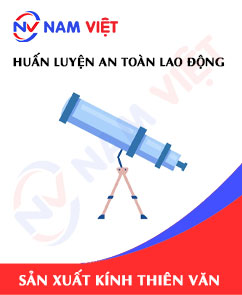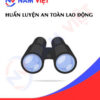Occupational Safety Training for Telescope Manufacturing
99,000 ₫
Note: The above price is calculated for one person, and the price may fluctuate depending on the number of learners participating in the course and market movements. For more accurate pricing support, please refer to the price list or contact our consulting staff directly.
Occupational safety is an important issue in telescope manufacturing factories and needs to be addressed promptly to ensure the health and safety of workers and enhance the reputation of enterprises. The Occupational Safety Training course is one of the effective solutions to raise awareness on how to prevent workplace accidents for workers participating in telescope manufacturing.
Table of Contents
Toggle1. Overview of telescope
a. What is a telescope?
A telescope is a type of optical instrument used in astronomy to observe and study the universe. It helps expand human observation capabilities to see distant objects in space such as stars, planets, nebulae, and other celestial bodies.
There are many different types of telescopes, among which the two most common are telescopes and binoculars.
- Telescope: This is a remote observation device that uses lenses or mirrors to focus and collect light from distant celestial sources. The light is directed into an optical system where the lenses or mirrors concentrate the light at a focal point, allowing the observer to see an enlarged image of the object.
- Binoculars: This is a small and lightweight telescope with two separate lenses placed side by side, allowing the user to view with both eyes at the same time. Binoculars are suitable for general observation of the night sky and can be easily carried when traveling or hiking.
Both types of telescopes help observers see celestial objects with higher resolution and more detail than with the naked eye.

b. Machinery for telescope manufacturing
The telescope manufacturing process usually involves many stages and uses different types of machinery to perform specific tasks. Below are some common machines involved in telescope manufacturing:
- Glass cutting and processing machines: These are specialized machines used to cut and process glass pieces used in telescopes. They can cut glass into the desired shape and perform processes such as grinding, sanding, polishing, and assembling with other components.
- Glass grinding and polishing machines: These machines are used to grind and polish the glass surface of telescope lenses. They ensure smooth and precise glass surfaces by performing grinding and polishing operations.
- Frame processing and manufacturing machines: These machines are used to process and manufacture the frames for telescopes. They can perform operations such as cutting, bending, grinding, and welding frame components.
- Coating machines: Telescopes are often coated with anti-reflective and light-enhancing coatings. Coating machines are used to apply these coatings to the glass surface. This process usually involves vacuum coating systems and special coating machines.
- Inspection and calibration machines: To ensure the quality and accuracy of telescopes, inspection and calibration machines are used to measure optical parameters such as resolution, blur, curvature, and geometric errors. These machines ensure telescopes meet quality requirements and standards.

c. Telescope manufacturing enterprises in Vietnam
Currently, I do not have information about all telescope manufacturing enterprises in Vietnam. However, there are some companies operating in this field. Below are some telescope manufacturing enterprises in Vietnam:
- Optics Technology Joint Stock Company (OTECH): OTECH is an enterprise headquartered in Ha Noi, specializing in manufacturing and distributing telescopes, binoculars, and other optical devices. They provide high-quality products for professionals and astronomy enthusiasts.
- Vixen Optics Vietnam: Vixen Optics Vietnam is a joint venture between Vietnam and Japan. This company specializes in manufacturing and distributing astronomical equipment such as telescopes, binoculars, and related accessories. Vixen Optics products are known for their high quality and advanced technology.
- Sky-Watcher Vietnam: Sky-Watcher is a famous brand of telescopes and astronomical equipment. This company is present in many countries around the world, including Vietnam. Sky-Watcher Vietnam provides quality products including telescopes, binoculars, and astronomical accessories.
Note that this list only mentions some enterprises operating in the field of telescope manufacturing in Vietnam and may not be complete. Researching more information about each specific enterprise will give you an overview of this field in the country.

d. Specific jobs in telescope manufacturing factory
Group 1
- Executive director, deputy executive director, department heads in telescope manufacturing factory.
Group 2
- Safety officers: managing safety in the factory, designing safety procedures, supervising and urging employees to comply with safe working procedures.
Group 3
- Glass manufacturing: The work of glass manufacturing includes processing and making glass pieces. This includes cutting, grinding, sanding, and polishing the glass pieces to create precise shapes and surfaces as required.
- Frame processing: Frame processing work includes cutting, bending, grinding, and welding frame components. Processing machines are used to produce frame components and assemble them into finished telescope products.
- Coating: An important stage in telescope manufacturing is coating the glass surfaces with anti-reflective and light-enhancing layers. This process usually uses vacuum sprayers and special coating machines to apply these layers.
- Assembly and inspection: After the glass and frame components have been manufactured, the assembly process takes place. The components are assembled according to procedures and carefully inspected to ensure the quality and performance of the telescope product.
- Inspection and calibration: Telescope products undergo inspection and calibration to ensure they meet quality standards and optical parameters such as resolution, blur, curvature, and geometric errors.
Group 4
- Office work, services, sales, marketing.
- Production management, quality management, human resource management, material management, financial accounting management.
- Design and research: The design and research team is responsible for researching, developing, and designing new telescope models. They create technical drawings, 3D models, and prototypes to test and evaluate before moving into the production phase.
2. Overview of occupational safety training course in telescope manufacturing
In this article, we focus on issues related to group 3, because group 3 is the group directly involved in manufacturing and faces the highest risks in occupational safety. Refer to other groups here
a. What is group 3 occupational safety training?
- Group 3 occupational safety training consists of lessons that provide awareness on how to prevent occupational accidents for employees.
- The occupational safety training course helps employees recognize and avoid hazards, thereby minimizing the risks of occupational accidents while working.
REGISTER FOR OCCUPATIONAL SAFETY TRAINING SERVICE
b. Training duration
First-time occupational safety training duration
- Total training duration is at least 24 hours, including examination time.
- 8 hours of theory on the system of occupational safety and hygiene policies and laws
- 8 hours of theory on basic knowledge of occupational safety and hygiene
- 4 hours of theory on specialized training content
- 2 hours of practice on specialized training content
- 2 hours of theoretical examination at the end of the training course
The occupational safety training center will arrange the schedule into multiple sessions depending on the organization of the factory for workers. Normally, there will be 6 training sessions conducted over 3 days, provided that the manufacturing enterprise arranges continuous learning time.
Periodic occupational safety training duration
- Before the occupational safety card expires, employees who want renewal must attend a periodic occupational safety training course, with a periodic training duration of at least 50% of the first-time training duration.
Explanation: The total periodic occupational safety training duration is at least 12 hours, including examination time. After completing the periodic training course and passing the examination, employees will be reissued or extended the occupational safety card.
c. Training course content
| No. | TRAINING CONTENT | TRAINING DURATION (HOURS) | |||
| Total | Including | ||||
| Theory | Practice | Examination | |||
| I | System of occupational safety and hygiene policies and laws | 8 | 8 | 0 | 0 |
| 1 | Overview of the system of legal documents on occupational safety and hygiene. | 6 | 6 | ||
| 2 | System of occupational safety and hygiene standards and technical regulations. | 1 | 1 | ||
| 3 | Specific regulations of state management agencies on occupational safety and hygiene when constructing, expanding, or renovating works, facilities for manufacturing, using, storing, preserving, and inspecting machines, equipment, materials, and substances subject to strict occupational safety and hygiene requirements. | 1 | 1 | ||
| II | Basic knowledge of occupational safety and hygiene | 8 | 8 | 0 | 0 |
| 1 | Basic knowledge of hazardous and harmful factors in the workplace. | 4 | 4 | ||
| 2 | Methods of improving working conditions. | 1 | 1 | ||
| 3 | Safety culture in manufacturing and business. | 1 | 1 | ||
| 4 | Rights and obligations of employers and employees; policies and regimes on occupational safety and hygiene for employees; functions and duties of the occupational safety and hygiene network. | 1 | 1 | ||
| 5 | Occupational safety and hygiene regulations, safety signs, instructions, and use of safety devices and personal protective equipment; first aid skills for occupational accidents and prevention of occupational diseases. | 1 | 1 | ||
| III | Specialized training content | 6 | 4 | 2 | 0 |
| General knowledge of machines, equipment, substances generating hazardous factors; analysis, assessment, and management of occupational safety and hygiene risks; safe working procedures with machines, equipment, and substances subject to strict occupational safety and hygiene requirements. | 6 | 4 | 2 | ||
| IV | Examination of occupational safety training content at the end of the course | 2 | 2 | 0 | 0 |
| Total | 24 | 22 | 2 | ||
See more training content of 6 groups
d. Occupational safety card
After completing the occupational safety training course and passing the examination, employees will be issued an occupational safety card (commonly referred to as a occupational safety certificate for group 3).
The group 3 safety card will clearly show information such as full name, date of birth, job title, and specific working environment. It also includes training duration, a red stamp, and a signature certifying completion of the training course.
According to the regulations on issuing safety cards specified in clause 2 of article 24 of decree 44/2016/ND-CP, it is divided into 2 cases:
- In case the employer and the employee have a labor contract, the employer must sign, stamp, and seal the safety card for group 3 employees after completing the training course from the occupational safety training unit and passing the examination.
- In case of freelance or seasonal workers without a labor contract, the training unit must sign, stamp, and seal the safety card for workers after they complete the training course from the occupational safety training unit and pass the examination.

3. Identifying Hazards Affecting Workers in Telescope Manufacturing
During the telescope manufacturing process, there are several potential hazards that may affect the health and safety of workers. Below are some common hazards in this field:
- Chemical hazards: Telescope manufacturing may involve the use of chemicals such as solvents, adhesives, dyes, and corrosive substances. Long-term or improper exposure to these substances can cause skin, eye, and respiratory irritation, and may be harmful to health.
- Hazards from tools and machinery: Telescope manufacturing often involves the use of cutting, processing, and assembly tools, as well as complex machinery. Unsafe or improper use can result in accidents causing worker injuries, including cuts, machinery-related injuries, and electrical safety issues.
- Hazards from ultraviolet rays and lasers: During coating and calibration processes, technologies involving ultraviolet rays or lasers may be used. Direct exposure without proper protective measures can cause burns, skin damage, and serious eye injuries.
- Hazards from temperature and pressure: Some stages of telescope manufacturing may involve high temperatures or high pressure. Working under these conditions without proper management and control can cause burns, heat stress, or suffocation.
- Hazards from noise: The telescope manufacturing process may generate noise from machinery, tools, and production operations.
- Electrical hazards: If electrical equipment in the factory is not regularly maintained, lacks insulation, or is not water-resistant, it can cause electric shocks to workers during production.

4. Common Occupational Accidents in Telescope Manufacturing
During the telescope manufacturing process, there are several types of occupational accidents that may occur, potentially causing injuries or fatalities to workers. Below are some common types of accidents in this field:
- Cutting accidents and injuries from tools and machinery: The use of cutting, grinding, and processing tools during telescope manufacturing may cause cutting accidents and injuries if safety rules are not followed, if personal protective equipment is not used, or if tools are used improperly.
- Chemical-related accidents: Telescope manufacturing may require the use of chemicals such as solvents, adhesives, and dyes. Accidents can occur if safety regulations for handling, storing, and transporting these chemicals are not followed.
- Injuries from temperature and pressure: Telescope manufacturing may involve technologies related to high temperatures or high pressure. Failure to comply with safety rules and not using protective equipment can cause burns or pressure-related injuries.
- Injuries from ultraviolet rays and lasers: During coating and calibration, technologies involving ultraviolet rays or lasers may be used. Direct exposure without adequate protection can cause burns, skin damage, and eye injuries.
- Accidents from falling objects and collapses: During the transportation, installation, and use of glass and frame components, accidents may occur due to falling objects or collapses. Without proper safety measures, workers may be injured by impact, crushing, or being pinned by heavy objects.
5. Safety Measures in Telescope Manufacturing
Participating in telescope manufacturing requires strict compliance with safety measures to protect workers’ health and safety. Below are some common safety measures in telescope manufacturing:
- Occupational safety training: Ensure that all employees are trained in safe work procedures, proper use of tools and machinery, and awareness of potential risks in the manufacturing process. Provide instructions on the use of personal protective equipment and specific safety rules.
- Use of personal protective equipment: Ensure that all employees are provided with and properly use appropriate personal protective equipment, including safety goggles, helmets, gloves, and steel-toed boots. Personal protective equipment helps protect against injuries and hazards during work processes.
- Use of safety equipment: Ensure that safety equipment such as cutting machines, grinding machines, coating machines, and lasers comply with safety standards and are maintained regularly. Safety equipment must be inspected and calibrated to ensure proper operation and avoid risks to workers.
- Chemical management: Store, use, and transport chemicals safely in compliance with legal regulations. Provide guidance on correct chemical handling, including wearing gloves, using ventilation systems, and proper placement of chemicals in the factory.
- Regular inspections and maintenance: Conduct periodic inspections and maintenance of equipment, machinery, and systems in the factory. This ensures that equipment functions properly, reducing risks of failures and workplace accidents.
- Regular occupational environment monitoring in factories and enterprises to collect and analyze harmful factors for workers, thereby making adjustments to reduce hazards and prevent occupational diseases.
6. Benefits of Occupational Safety Training in Telescope Manufacturing
An Toan Nam Viet provides enterprises with great benefits after completing occupational safety training courses in accordance with the regulations of Decree 44/2016/ND-CP on occupational safety and hygiene for companies, factories, and enterprises.
- Workers can recognize potential risks of occupational accidents and take preventive measures to avoid incidents.
- Enterprises can establish risk prevention measures in manufacturing, operation, and maintenance processes.
- Minimize costs related to occupational safety incidents.
- Ensure uninterrupted production, which improves productivity and product quality.
- Comply with occupational safety laws, avoiding legal risks.
- Enhance reputation and professionalism, thereby elevating the brand of the enterprise.
Nam Viet’s training courses are effective solutions to prevent external factors from harming individuals, helping them avoid risks that may lead to injuries or fatalities.
REGISTER FOR OCCUPATIONAL SAFETY TRAINING SERVICE
7. Customer Feedback After Completing Occupational Safety Training in Pallet Manufacturing
An Toan Nam Viet has many years of experience in the mission of accompanying many enterprises across Vietnam in general and in the southern provinces in particular. This responsibility is extremely valuable to Nam Viet, which is why the Occupational Safety Training activities of Nam Viet are always increasingly professional. The driving force for An Toan Nam Viet to grow strongly up to now comes from positive feedback as well as suggestions from enterprises. Below are the feedbacks from our valued partners that we have served.
Bac Nam E&C Construction Investment Joint Stock Company
“This is the first time using the service at An Toan Nam Viet and I was very surprised by the enthusiastic 24/7 support from the team of consultants. The class organization was very quick and convenient for our company, thank you very much for Nam Viet’s service!”
Hoa Dat Construction and Trading Joint Stock Company
“Nam Viet’s service has helped us a lot in simplifying occupational safety and completing safety records to serve the working process. The consulting team was enthusiastic and timely in answering our questions. 5 stars for Nam Viet.”
See more customer interviews after using the service of An Toan Nam Viet
8. Occupational Safety Training Capacity of An Toan Nam Viet
An Toan Nam Viet is a reputable and high-quality occupational safety training center in Vietnam today. Occupational safety training sessions are continuously held at manufacturing workshops, factories, or construction sites across the country (63 provinces and cities in Vietnam).
REGISTER FOR OCCUPATIONAL SAFETY TRAINING SERVICE
License for occupational safety training
- An Toan Nam Viet has been inspected and certified by the Department of Safety under the Ministry of Labor – Invalids and Social Affairs with the certificate of eligibility for occupational safety and hygiene training activities. This further strengthens the training capacity of occupational safety training of our center.

Documents and lectures
- Before occupational safety training materials are applied in occupational safety training courses, they are carefully reviewed and verified to ensure that the lectures are always accurate and effective when applied.
- The teaching methods of the trainers are standardized according to the teaching standards of An Toan Nam Viet, which are methods studied and developed by experts in occupational safety and hygiene training to maximize knowledge absorption for learners.
Facilities
- Controlling classroom factors that affect the training process will improve teaching efficiency and learner knowledge absorption.
- Training support facilities of our center are always equipped with spacious classrooms that meet standards of space, lighting, training equipment, etc.
9. Nationwide Reputable Occupational Safety Training Center
At An Toan Nam Viet, we always place the mission of occupational safety training as the top priority. For us, equipping workers with self-protection knowledge so they can have safety on their livelihood journey is also contributing to building the country.
To ensure training effectiveness, we carefully prepare every detail, even the smallest. From preparing tools, teaching equipment, curricula, documents, sound, and lighting.
Our occupational safety trainers are experts with many years of experience in the field. They even have research projects on identifying hazards in all industries and how to prevent them.
The lectures of trainers are distilled from practice and conveyed vividly and clearly to workers. These factors help workers feel comfortable during study and absorb the knowledge effectively. Of course, the conveyed knowledge always adheres to Decree 44/2016/ND-CP.
From there, workers gain knowledge of many preventive measures and self-protection methods. At the same time, they can apply them appropriately in actual work.
Our safety training center is proud to be a provider of professional and reputable occupational safety training services nationwide with the following advantages:
- Competitive training costs while still ensuring training quality.
- Flexible training schedules to suit the production situation of enterprises.
- Quick certification procedures in accordance with the law.
- Trainers with many years of industry experience.
- Classrooms controlled for factors affecting the training process, improving teaching efficiency and knowledge absorption.
- Lectures are compiled to suit occupational safety practices at enterprises.
- An Toan Nam Viet works wholeheartedly and professionally to provide customers with accurate and fastest support.

10. Additional References for Occupational Safety Training in Pallet Manufacturing
- Pallet manufacturing occupational safety materials
- Occupational safety training materials set
- Occupational safety training test set
- Pallet manufacturing occupational safety multiple-choice test
- Slides for occupational safety training in pallet manufacturing
1 review for Occupational Safety Training for Telescope Manufacturing
No comments yet















namchinh.haiphong341
Giảng viên dạy rất sinh động dễ hiểu!